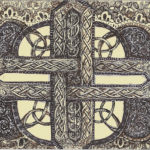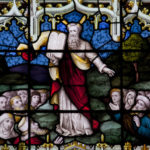We run our website the way we wished the whole internet worked: we provide high quality original content with no ads. We are funded solely by your direct support. Please consider supporting this project.

How The Imperfections of Scripture Reveal God Perfectly
In my previous blog I discussed one important implication of a cruciform (“cross-centered”) approach to biblical inspiration. On the cross, I noted, God revealed his perfection by identifying with human imperfection. Jesus in some sense became our sin and our curse. In this light, I argued, why should anyone find it surprising, let alone disturbing, that God’s revelation in Scripture contains human imperfections (inconsistencies, historical and scientific inaccuracies, historically conditioned theologies, etc.)? In this post I’d like to take this discussion a step further.
Largely on the basis of 2 Timothy 3:16, Christians throughout history have confessed that the Bible is “divinely inspired.” However, the word Paul uses to describe Scripture (theopneustos) literally means “God-breathed.” It’s a powerful metaphor that sets Scripture apart from every other book in the world! But as with all metaphors that are applied to God, we need to take care to discern what aspects of the breathing process are to be attributed to God, and which aspects are not. Since breathing is an activity we do completely on our own, conservative Christians have usually assumed that the Bible was “breathed” by God completely on his own. And since there were no outside influences in God’s “breathing” process, it is usually concluded that the Bible must reflect God’s own perfection. In other words, it must be completely mistake–free or “inerrant.”
I believe that this is a mistaken and unfortunate application of this metaphor. As I noted in my previous blog, and as many of us know from our own experience, this way of thinking about biblical inspiration has set many up to have their faith smashed when they discover they have no intellectually honest way to deny that Scripture contains things such as contradictions, historical inaccuracies, and antiquated cosmological and theological ideas. It’s tragic and entirely unnecessary.
Instead of assuming we know at the start what the process of God’s “breathing” entails, I suggest we ought to anchor our reflections of this process in the cross. If the cross is the definitive revelation of God, as I’ve argued, then it reveals what God is truly like and thus what God has always been like in all of his activities. We should therefore try to understand God’s “breathing “of Scripture in this light. As we assume this approach, we find we have no reason to think that God’s “breathing” was something he did completely on his own, excluding all outside influences. To the contrary, God “breathed” his self-revelation on the cross not merely by acting toward humans, but also by allowing others to act on him. In other words, there was an active as well as a passive dimension to God’s revelation on the cross at Calvary.
Active and Passive Dimensions of God-Breathing
Think about it. God obviously took action toward us when he devised the plan of salvation and then began to implement it by becoming a human being. And he obviously took action toward us when Jesus taught and acted in ways that provoked authorities and insured that he would get him arrested, beaten, and crucified. But it’s also evident that God was, to some extent, passive in his self-revelation on Calvary inasmuch as he allowed wicked humans and fallen forces of evil to violently act towards him. Indeed, it’s only because the process by which God “breathed” his definitive revelation on the cross included a passive dimension that it was able to manifest his humble, other-oriented, self-sacrificial love. God thus “breathed” his self-revelation on the cross not only by taking action, but also by subjecting himself to the action of others.
Since the God who “breathed” Scripture is also the God who revealed himself on the cross, and since the most fundamental purpose of Scripture is to bear witness to the revelation of God on the cross, we have every reason to assume that the process by which he “breathed” Scripture included an active as well as a passive element. As a matter of fact, the correctness of this assumption is confirmed by the simple fact that the books of the Bible all reflect the distinct personalities, writing styles, and cultural conditioning of their human authors. God clearly allowed the humanity of these authors to act on him and condition the content that he “breathed” through them.
Even more importantly, this passive aspect of God’s “breathing” is confirmed in the fact that Scripture incorporates the questions, confessions, and even mistaken perspectives of the human authors. When the grief-stricken Job exclaims that God “mocks at the calamity of the innocent” and “covers the eyes of [earth’s] judges” so they rule unjustly (Job 9:23-24), for example, it’s evident that God is allowing Job’s mistaken theological perspective to condition his “breathing.”
A God Revealed Perfectly Through Imperfection
What this means, among other things, is that we must read Scripture with the understanding that, while it is all “God-breathed,” it is not all the result of God’s action. As is the case with his self-revelation on the cross, some of what God “breathed” in Scripture is the result of him humbly subjecting himself to the action of others. And this means we must read Scripture with the awareness that, while all Scripture reveals God, it does not all do so directly. The revelation of God in passages such as Job 9:23-24 is not found directly on the surface of the text, for this content, we saw, is mistaken. Rather, Job 9:23-24—as well as every other passage that reflects the limited, culturally-conditioned and fallen perspectives of its author—indirectly reveals God by bearing witness to his humble, other-oriented, self-sacrificial love. That is, while the content of passages like this reflects the limited and fallen humanity of its author, the very fact that God was not above stooping to embrace it as his own by incorporating it into the canon indirectly bears witness to his humility and grace.
When we understand God’s “breathing” in light of the definitive revelation that he “breathed” on the cross, we are in a position that allows us to see how Scripture’s imperfections are not only not a problem; we can now see how they bear witness to Christ. The revelation of God on Calvary is not found in what is directly visible – that is, in the apparently God-forsaken human dying an agonizing death. The revelation is rather discerned with eyes of faith as we see in this crucified man the humble Creator, stooping to identify with our humanity and our sin. So too, the revelation of God in passages that reflect the imperfect, culturally-conditioned, fallen perspective of their authors is found not in what is directly visible – namely, in their expressed content. It is rather discerned with the eyes of faith as we see in this content the humble Creator who is not above allowing humans to impact him and condition his “breathing.”
Finally, once we understand that God’s “breathing” includes a passive as well as an active dimension, we can admit that some biblical portraits of God reflect the culturally-conditioned and fallen perspectives of their authors without thereby denying that these portraits are “God-breathed.” In fact, we begin to see how these imperfect portraits of God nevertheless perfectly reveal God by indirectly bearing witness to the crucified Christ. To the extent that any portrait accurately reflects God’s true character, as definitively revealed in Christ, we may surmise that it is a “God-breathed” direct revelation. To the extent that any divine portrait does not accurately reflect God’s true character, however, we may surmise that it is a “God-breathed” indirect revelation, bearing witness to a humble, other-oriented, self-sacrificial God who is not above stooping to make such portraits his own, just as we was not above stooping to make our limited and fallen humanity his own on the cross.
And now, I submit, we are in a position to begin to see how a portrait of Yahweh commanding his people to “show no mercy” as they murder every man, woman, child, and animal in Canaan might not only be consistent with, but might actually point to, the God who became a man who gave his life for enemies on the cross while praying for their forgiveness with his last breath.
_____
Category: General
Tags: Cruciform Theology, Inerrancy, Scripture
Related Reading

Does Paul Condone Vindictive Psalms? A Response to Paul Copan (#1)
In a recent paper delivered at the Evangelical Theological Society, Paul Copan raised a number of objections against my book, Crucifixion of the Warrior of God. This is the first of several blogs in which I will respond to this paper. (By the way, Paul and I had a friendly two-session debate on Justin Brierley’s…

Two Questions to Unlock Violent Divine Portraits
There are two basic questions that help us to interpret what is going on in the violent portraits of God in the Old Testament, as I propose in Crucifixion of the Warrior God. The First Question: What does the “God-breathed” revelation of the cross teach us about the nature of God’s “breathing”? God “breathed” his…

Justice and Biblical Clarity in Hindsight
Murky1 via Compfight Rachel Held Evans posted a challenging look at our history of using the Bible to uphold things like slavery and to condemn people like Galileo for his scientific findings. You really need to check out the specific quotes she cites to experience the full horror of the ways the Bible was used…

The Cross and The Trinity
Out of love for humankind, Scripture tells us, Jesus emptied himself of his divine prerogatives, set aside the glory he had with the Father from before the foundation of the world, became a human being and bore our sin as he died a God-forsaken death on Calvary (Phil 2:5-7). Though Jesus remained fully God, he…

Would God Kill a Baby To Teach Parents a Lesson?
Question: We have a group of guys that are going through your book “Is God to Blame” and a question came up that I would be curious how you would look at it. In the beginning of the book you ask the question “do you really think that God kills babies to teach parents a lesson?”…

Did God Give Violent Laws? A Response to Paul Copan (#13)
In his critique of Crucifixion of the Warrior God (CWG) at the Evangelical Theological Society annual meeting in November, Paul Copan takes issue with my contention that the violent dimension of OT laws reflects God accommodating the fallen and culturally conditioned perspectives of his people at this time. In my view, God was stooping to…
